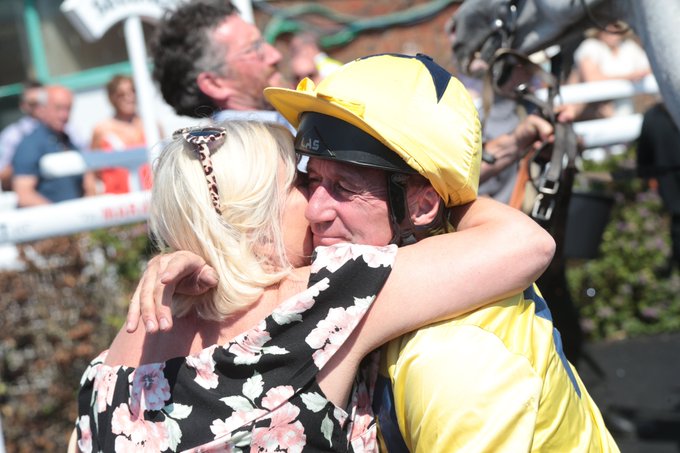Roy Rocket, 2010-2021
- Emma Berry

- Apr 10, 2021
- 6 min read
Updated: Apr 11, 2021

Roy Rocket, the one time co-record holder for the most number of wins at Brighton, has died. He was 11.
That’s the style in which I would normally start an obituary, for a horse or human who has left their mark on the racing world. I wouldn’t normally be writing an obituary for a middle-of-the-road handicapper. And I wouldn’t normally be writing at four o’clock in the morning, but Roy wasn’t normal, he was special, and he died yesterday. And when something terrible has happened, for days afterwards my brain wakes me at the hour of dread, always at ten to four, and after that it seems pointless to lie in bed fretting.
In a few hours Jana, Abbie, Ivona and Vendi will arrive at the yard and the daily routine will begin again. They left yesterday in tears after Roy didn’t return from first lot. This morning none of us will want to walk past his empty box but there’s no avoiding it. It’s the one right next to the tack room and feed room, the one closest to our house, the one which, once the sun is up, I can see from the window next to me as I type.

Roy was born in France, 11 years and one week ago. He was bred by John, his trainer, who co-owned him with our dear friends Iris and Larry McCarthy. Iris’s late husband Joe had been like a father to John, and he had been a lucky and loyal owner for this yard. Every horse Joe raced in his yellow and navy silks had won, and after he died in 2006 we were touched that Iris and Larry wanted to keep the colours going. With Roy, however, at first it seemed as if the McCarthy luck had run out.
Roy started racing in the October of his two-year-old season but it took him 16 starts and two and a half years to win. That first one came at Brighton almost six years ago on April 21 and, clearly delighted with himself, he decided to win there again the following week. So began a love affair with the quirky seaside track. In return, the Brighton faithful loved him back. He ran there 31 times for nine wins, two seconds and six third-place finishes.

But those are just the statistics. Roy’s trips to Brighton became like high days and holidays. I spend much of my time writing about the top horses, and I fully support the racing and breeding ethos of striving for and rewarding the very best. To be among the best, of course, is to be in rarefied company, meaning that those we regard in that bracket every year number into the low hundreds at most. There are more than 14,000 horses in training in Britain alone. They can’t all be great, or even good, and plenty of horses may never even win a race.
Roy won nine, once rising to the lofty mark of 74 but more usually plying his trade in the 50s. But to go to the races with him, to Brighton especially, was to remember that racing, as much as it is about deciding who’s best, is also about entertainment. Without people enjoying it, and continuing to support the sport or perhaps even becoming an owner or breeder, we would have nothing.
In the later years, Roy’s arrival at Brighton would start with a cheery call from the road crossing attendant as he was unloaded from the lorry and walked across to the stables. “Here he is, the Brighton legend,” he would say without fail.

That Roy was almost white by the time he was five made him easy to spot, and plenty of his followers would make a point of finding a place on the parade ring rail to watch him go out and, win or lose, cheer him back in. As he went to post, Iris, now 86 and no more than 5ft tall, would produce from one of her many voluminous handbags a flask of gin and tonic and insist that John took a swig for luck. It sometimes worked.
Roy won all his races by being dropped out last before coming with a rattling run up that hill for home. At the festival-like August meetings especially, you could hear people start to shout for him. “Here he comes,” the cry would go up, along with the volume. Brighton, toppling high on the chalky South Downs, suited him perfectly as the easy-draining ground there is often fairly quick, allowing Roy to scuttle across it in his strange, short, low action. He couldn’t really cope with soft ground, which is what made his final win all the more special.
“Roy Rocket, he’s getting up, it’s a ninth course win. He’s done it. Roy’s the boy at Brighton,” shouted commentator Simon Holt as our horse crossed the line, seemingly as thrilled and surprised as we all were that soggy day.

That year, Roy’s growing status as a bit of a cult hero was acknowledged at the ROA Awards. In an open vote of members for the Flat Special Achievement Award, he beat the 1,000 Guineas winner among others. It was the only time he could hold his own in Group 1 company, but the people had voted for a horse who made lots of them happy.
He made us happy too, even when he was up to his antics, which included helping himself in the feed room if left unguarded while he was having his morning wander round the yard post-exercise. As much as the saying ‘horses for courses’ can often hold true, especially in Roy’s case, I also believe, up to a point, that there are horses for trainers, or vice versa.
Roy was every bit as singular as the man who trained him. John runs something of a free-range racing stable, which wouldn’t be at all eyebrow-raising if he trained on a farm in the middle of nowhere, but in Newmarket, alongside the vast strings of bluebloods, his methods can be viewed as unusual. John’s maxim of being a benevolent dictator towards his horses didn’t really cut much ice with Roy, who decided from quite an early age that he would be the one who decided on his regime.

Hence, you could never travel him to the races with another horse: he needed the full two-box, with all partitions removed, to himself. There were certain parts of the Heath John would never dare take him for fear of Roy being held up behind a big string and turning cartwheels in frustration at being made to wait. Warren Hill was out, but he would bowl happily up Long Hill, head down low, as long as he was allowed the freedom of the yard and an afternoon in the field, coating himself in mud, in return.
That John gladly gave him, and he gave us some of the best days of our racing lives. The pandemic has scuppered many plans for many people and, with Brighton shuttered for all of last season, Roy had only two underwhelming runs elsewhere before John decided to give him a proper break in the hope of a return to his favourite place this year.
As spring emerged from the bleakness of a lockdown winter, Roy had been his usual ebullient self until on Friday morning he went out to work and didn’t come back. Realising early in the gallop that something was amiss, John managed to pull him up and dismount. Seconds later, Roy took his last breath with the person who loved him best at his side and sank to the turf.

When Roy went to the races for the first time in October 2012, we walked him over to the Rowley Mile with his stable-mate Many Levels, who was making his debut in the same maiden. John’s blog post that night was titled ‘All my sons’, which is how he regards the horses in this stable. This, in part, was his assessment of that day, which marked John’s first experience of training a horse that he owned and bred:
“They beat a few, which in an ordinary race wouldn't be much of an achievement, but in Newmarket maidens at this time of year is fine because all the horses in the field tend to be nice horses, so cutting not significantly less ice than the bulk of the others is fine. It's early days yet – but when horses go to the races for their debut, behave impeccably, run adequately and come home clearly having enjoyed the outing, then you feel as if you've had a winner. Especially when one of them is one whose life you've been overseeing since a long time before he was conceived, never mind born.
“If I can ever achieve any amount of success in this three-fold role, however small that amount can be, then that would be a really lovely thing.”
It was a lovely thing indeed, and 68 races and almost nine years later, Roy’s record stands testament not just to his own great zest for life, but to his trainer’s patience, care and indulgence.
We mourn him today and we will miss him forever. But now there’s light in the sky and work to be done. Life goes on, just more unhappily than before.







































So sad for everyone that loved roy rocket especially john and the family who gave him the best life ,A statue of Roy at brighton racecourse would be a fitting tribute to how much this beautiful horse touched all our hearts 😢
This is terribly sad news,this little horse brightened up everybodys day,andIreally looked forward to his runs at Brighton,thankfully he had a fantastic trainer with him until the end.God bless you John Berry and Roy.
Emma, a wonderful obituary for the legend that was Roy Rocket. It certainly brought tears to my eyes and a handkerchief was required. My sincerest condolences to you and all the staff at Beverley House Stables and in particular to John at this sad time. Roy may have passed his last finishing post but he will never be forgotten. Love to All x
John it's so hard to read your lovely obituary of a wonderful racehorse who epitomises what racing is all about and your passion and love for these beautiful equines and dedication and care you have for your horses I am just so glad he did not suffer to long and I am sure you been with him knowing that he was cared and loved he knew its very hard when you lose a friend and Roy was a great one but hopefully you get another one I know he can't be replaced but your skills may bring out the best of another eqine friend thanks for the memories Roy you will never be forgotten.
So sorry to read that Roy Rocket has passed away. A beautiful horse. Loved meeting him at the Newmarket Open Event a couple of years ago.